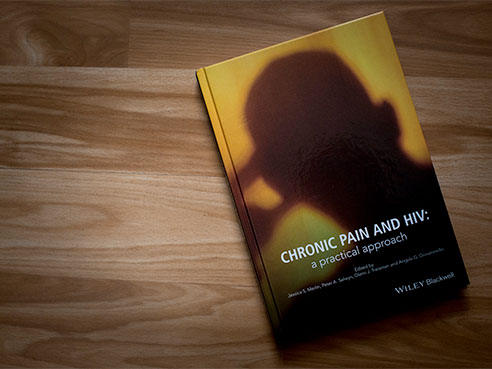 Recent studies suggest many individuals with HIV have chronic pain. Estimates range from 39 percent all the way to 85 percent. Chronic pain is an important comorbid condition in individuals with HIV, as it is common and causes substantial disability.
Recent studies suggest many individuals with HIV have chronic pain. Estimates range from 39 percent all the way to 85 percent. Chronic pain is an important comorbid condition in individuals with HIV, as it is common and causes substantial disability.
In the current HIV treatment era, HIV is a chronic disease with a near-normal life expectancy. However, individuals with HIV can have higher rates of other health problems than the general population.
A new reference guide for HIV care providers, “Chronic Pain and HIV: a practical approach,” offers insight into the assessment, diagnosis, testing and management of various chronic pain problems in patients with HIV.
Lead editor Jessica Merlin, M.D., an assistant professor in the University of Alabama at BirminghamSchool of Medicine Division of Infectious Diseases and Division of Geriatrics, Gerontology and Palliative Care, says the guide addresses issues that HIV care providers have when trying to provide relief to HIV patients with chronic pain, including pharmacological and non-pharmacological therapies.
“Chronic pain is increasingly recognized as an important comorbidity in HIV-infected patients, and may influence adherence to antivirals and retention in care,” Merlin said. “Individuals with HIV also have higher rates of mental illness and addiction than the general population. HIV, mental illness and addiction are all highly stigmatized health problems, further compounding patients’ suffering.”
HIV and the medications once used to treat the disease can lead to nerve pain in the hands and feet in as many as 40 percent of patients. Also, for reasons that are not well-understood, patients with HIV may have a high burden of musculoskeletal pain, like joint pain, back pain and more widespread pain.
Non-pharmacologic treatments are an important mainstay of therapy, including graded exercise, complementary and alternative therapies, and behavioral therapies. Importantly, behavioral therapies are among the safest and most effective treatments for chronic pain. In 2014, Merlin was awarded a K23 Career Development Award from the National Institute of Mental Health. She is working on developing and pilot-testing a behavioral intervention that is specifically tailored to improving chronic pain in individuals with HIV.
Ideally, when medications are used, they should be prescribed alongside non-pharmacologic therapies.
“A multimodal approach is the most effective approach,” Merlin said. “Our book helps front-line HIV primary care providers use this approach with their patients.”
| “Managing chronic pain is rewarding; but it can be challenging, and is often not taught in HIV providers’ medical training. This book is the first practical guide on the topic for HIV care providers, and fills an important need.” |
Medications such as opioids may not be as effective, and carry significant risks.
“Chronic pain can be challenging to manage to begin with, and even more challenging to manage in the setting of mental health and addiction problems found in individuals with HIV,” Merlin said. “Long-term treatment with opioids, such as morphine, oxycodone and others, has been commonly used to treat chronic pain in general and in individuals with HIV. Opioid therapy carries risks such as worsening of mood, development of addiction and overdose, and these risks can be heightened in the presence of pre-existing mental illness and addiction.”
Studies suggest that HIV care providers may feel unprepared to treat chronic pain.
“Managing chronic pain is rewarding; but it can be challenging, and is often not taught in HIV providers’ medical training,” Merlin said. “This book is the first practical guide on the topic for HIV care providers, and fills an important need.”
“Chronic Pain and HIV: a practical approach,” published by John Wiley & Sons, Inc., is available for purchase online on Amazon.com. The Kindle version is available now, and the hardback version will be available in April for $120.